2011 Peugeot 3008 Hybrid 4 ECO mode
[x] Cancel search: ECO modePage 37 of 280
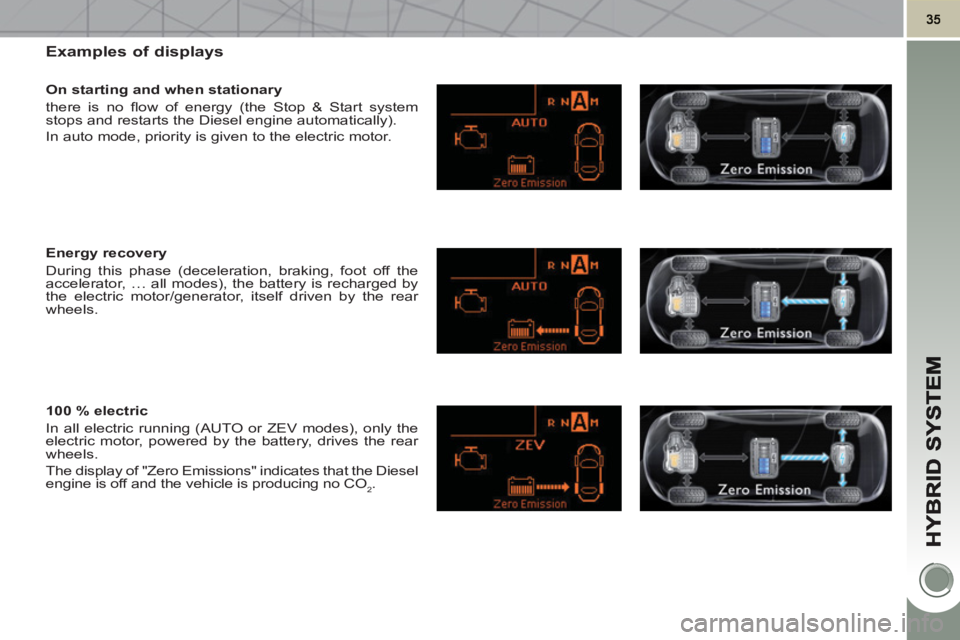
Examples of displays
On starting and when stationary
there is no fl ow of energy (the Stop & Start system
stops and restarts the Diesel engine automatically).
In auto mode, priority is given to the electric motor.
Energy recovery
During this phase (deceleration, braking, foot off the
accelerator, … all modes), the battery is recharged by
the electric motor/generator, itself driven by the rear
wheels.
100 % electric
In all electric running (AUTO or ZEV modes), only the
electric motor, powered by the battery, drives the rear
wheels.
The display of "Zero Emissions" indicates that the Diesel
engine is off and the vehicle is producing no CO
2.
Page 38 of 280
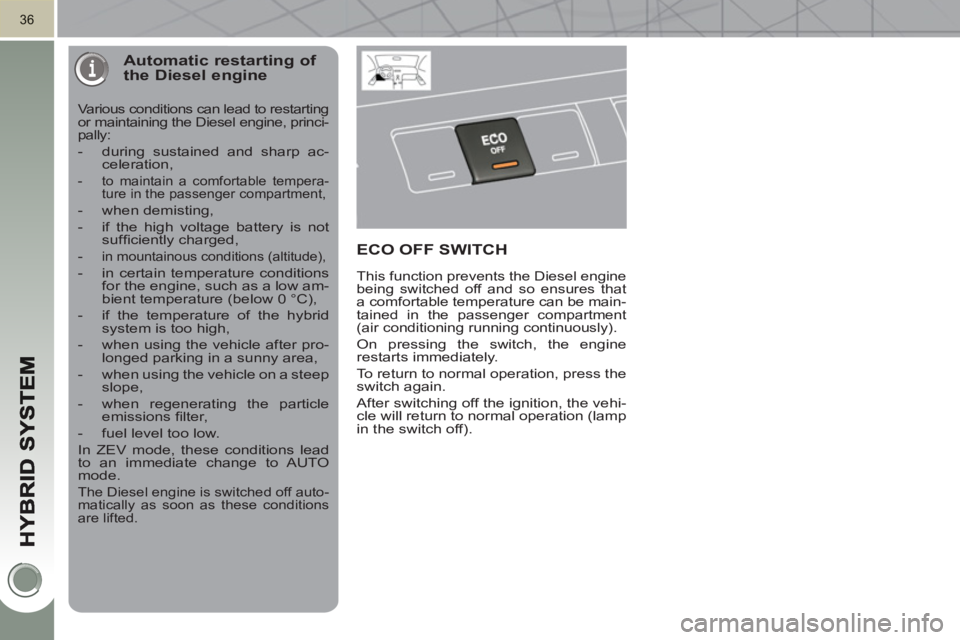
36
Automatic restarting of the Diesel engine
Various conditions can lead to restarting
or maintaining the Diesel engine, princi-
pally:
- during sustained and sharp ac-
celeration ,
- to maintain a comfortable tempera-
ture in the passenger compartment,
- when demisting,
- if the high voltage battery is not
suffi ciently charged,
-
in mountainous conditions (altitude),
- in certain temperature conditions
for the engine, such as a low am-
bient temperature (below 0 °C),
- if the temperature of the hybrid
system is too high,
- when using the vehicle after pro-
longed parking in a sunny area,
- when using the vehicle on a steep
slope,
- when regenerating the particle
emissions fi lter,
- fuel level too low.
In ZEV mode, these conditions lead
to an immediate change to AUTO
mode.
The Diesel engine is switched off auto-
matically as soon as these conditions
are lifted.
ECO OFF SWITCH
This function prevents the Diesel engine
being switched off and so ensures that
a comfortable temperature can be main-
tained in the passenger compartment
(air conditioning running continuously).
On pressing the switch, the engine
restarts immediately.
To return to normal operation, press the
switch again.
After switching off the ignition, the vehi-
cle will return to normal operation (lamp
in the switch off).
Page 39 of 280
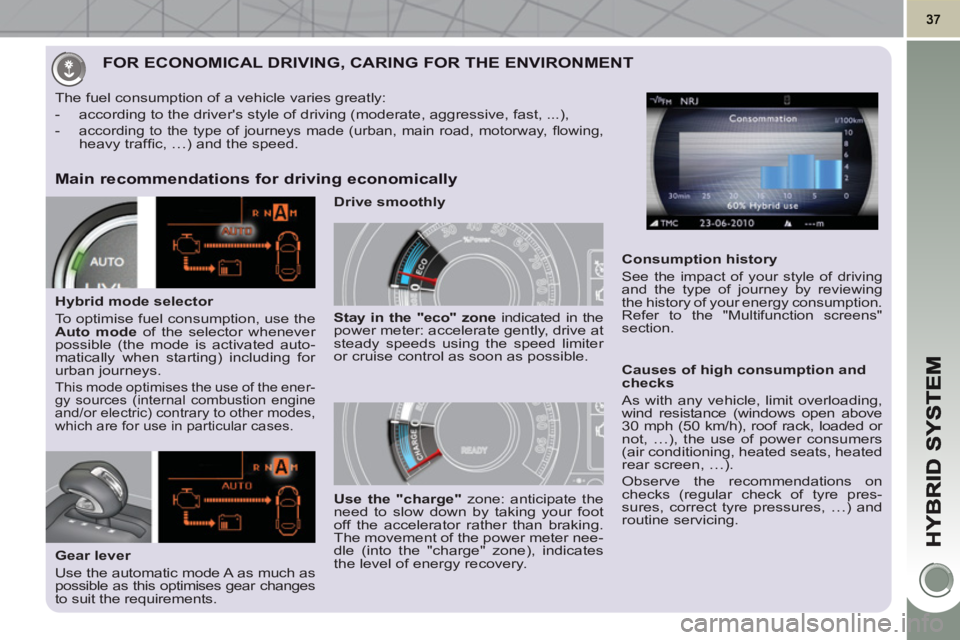
FOR ECONOMICAL DRIVING, CARING FOR THE ENVIRONMENT
Main recommendations for driving economically
Drive smoothly
The fuel consumption of a vehicle varies greatly:
- according to the driver's style of driving (moderate, aggressive, fast, ...),
-
according to the type of journeys made (urban, main road, motorway, fl owing,
heavy traffi c, …) and the speed.
Hybrid mode selector
To optimise fuel consumption, use the
Auto
mode
of the selector whenever
possible (the mode is activated auto-
matically when starting) including for
urban journeys.
This mode optimises the use of the ener-
gy sources (internal combustion engine
and/or electric) contrary to other modes,
which are for use in particular cases.
Gear lever
Use the automatic mode A as much as
possible as this optimises gear changes
to suit the requirements.
Stay in the "eco" zone
indicated in the
power meter: accelerate gently, drive at
steady speeds using the speed limiter
or cruise control as soon as possible.
Causes of high consumption and
checks
As with any vehicle, limit overloading,
wind resistance (windows open above
30 mph (50 km/h), roof rack, loaded or
not, …), the use of power consumers
(air conditioning, heated seats, heated
rear screen, …).
Observe the recommendations on
checks (regular check of tyre pres-
sures, correct tyre pressures, …) and
routine servicing.
Use the "charge"
zone: anticipate the
need to slow down by taking your foot
off the accelerator rather than braking.
The movement of the power meter nee-
dle (into the "charge" zone), indicates
the level of energy recovery.
Consumption history
See the impact of your style of driving
and the type of journey by reviewing
the history of your energy consumption.
Refer to the "Multifunction screens"
section.
Page 41 of 280
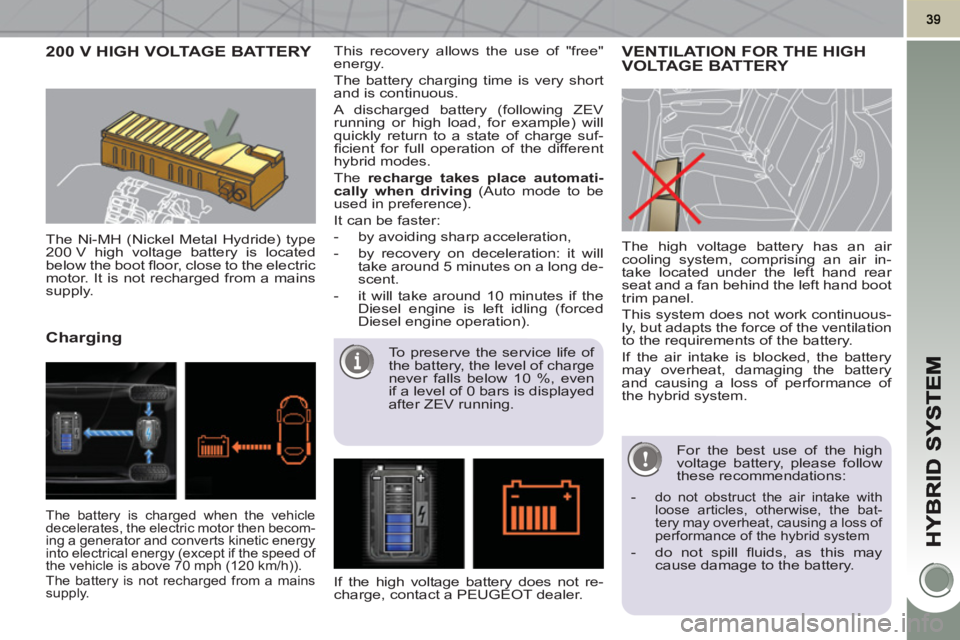
200 V HIGH VOLTAGE BATTERY
The Ni-MH (Nickel Metal Hydride) type
200 V high voltage battery is located
below the boot fl oor, close to the electric
motor. It is not recharged from a mains
supply.
Charging
This recovery allows the use of "free"
energy.
The battery charging time is very short
and is continuous.
A discharged battery (following ZEV
running or high load, for example) will
quickly return to a state of charge suf-
fi cient for full operation of the different
hybrid modes.
The recharge takes place automati-
cally when driving
(Auto mode to be
used in preference).
It can be faster:
- by avoiding sharp acceleration,
- by recovery on deceleration: it will
take around 5 minutes on a long de-
scent.
- it will take around 10 minutes if the
Diesel engine is left idling (forced
Diesel engine operation).
The high voltage battery has an air
cooling system, comprising an air in-
take located under the left hand rear
seat and a fan behind the left hand boot
trim panel.
This system does not work continuous-
ly, but adapts the force of the ventilation
to the requirements of the battery.
If the air intake is blocked, the battery
may overheat, damaging the battery
and causing a loss of performance of
the hybrid system. VENTILATION FOR THE HIGH VOLTAGE BATTERY
For the best use of the high
voltage battery, please follow
these recommendations:
-
do not obstruct the air intake with
loose articles, otherwise, the bat-
tery may overheat, causing a loss of
performance of the hybrid system
- do not spill fl uids, as this may
cause damage to the battery.
The battery is charged when the vehicle
decelerates, the electric motor then becom-
ing a generator and converts kinetic energy
into electrical energy (except if the speed of
the vehicle is above 70 mph (120 km/h)).
The battery is not recharged from a mains
supply.
If the high voltage battery does not re-
charge, contact a PEUGEOT dealer.
To preserve the service life of
the battery, the level of charge
never falls below 10 %, even
if a level of 0 bars is displayed
after ZEV running.
Page 47 of 280

Vehicle parameters
This menu allows you to activate or
deactivate certain driving and comfort
equipment (according to country):
- wiper linked with reverse gear (refer
to the "Visibility" section),
- selective unlocking (refer to the
"Access" section),
- guide-me-home and welcome lighting
(refer to the "Visibility" section),
- interior mood lighting (refer to the
"Visibility" section),
- daytime running lamps (refer to the
"Visibility" section),
- directional headlamps (refer to the
"Visibility" section),
- automatic or manual parking brake
(refer to the "Driving" section).
Choice of units
This menu allows you to select the
units: temperature (°Celsius or °Fahr-
enheit) and fuel consumption (l/100 km,
mpg or km/l).
Choice of language
This menu allows you to select the
display language: Deutsch, English,
Espanol, Français, Italiano, Nederlands,
Portugues, Türkçe * .
*
According to country. Indicator and warning lamps
Visual indicators informing the driver
that a system is in operation (operation
or deactivation indicator lamps) or of the
occurrence of a fault (warning lamp).
When the ignition is switched on
Certain warning lamps come on for a
few seconds when the vehicle's ignition
is switched on.
When the engine is started, these same
warning lamps should go off.
If they remain on, before moving off, refer to the
information on the warning lamp concerned.
Associated warnings
The illumination of certain warning
lamps may be accompanied by an au-
dible signal and a message in the multi-
function screen.
The warning lamps may come
on continuously (fi xed) or
fl ash.
Certain warning lamps may come on
in two different modes. Only by re-
lating the type of illumination to the
operating status of the vehicle can it
be ascertained whether the situation
is normal or whether a fault has oc-
curred.
Page 59 of 280
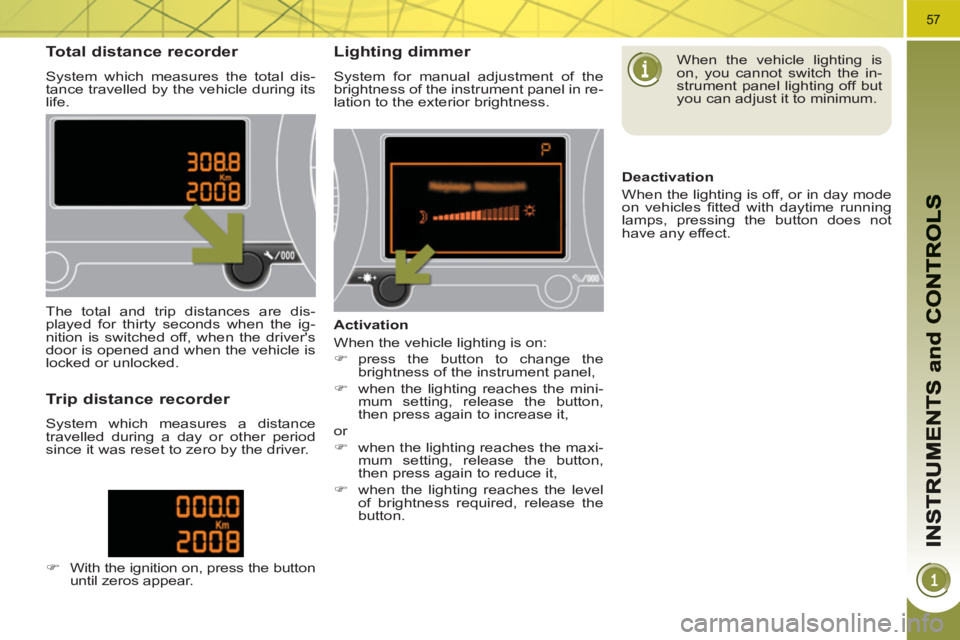
57
Total distance recorder
System which measures the total dis-
tance travelled by the vehicle during its
life.
Lighting dimmer
System for manual adjustment of the
brightness of the instrument panel in re-
lation to the exterior brightness.
The total and trip distances are dis-
played for thirty seconds when the ig-
nition is switched off, when the driver's
door is opened and when the vehicle is
locked or unlocked.
Trip distance recorder
System which measures a distance
travelled during a day or other period
since it was reset to zero by the driver.
�)
With the ignition on, press the button
until zeros appear.
Activation
When the vehicle lighting is on:
�)
press the button to change the
brightness of the instrument panel,
�)
when the lighting reaches the mini-
mum setting, release the button,
then press again to increase it,
or
�)
when the lighting reaches the maxi-
mum setting, release the button,
then press again to reduce it,
�)
when the lighting reaches the level
of brightness required, release the
button.
When the vehicle lighting is
on, you cannot switch the in-
strument panel lighting off but
you can adjust it to minimum.
Deactivation
When the lighting is off, or in day mode
on vehicles fi tted with daytime running
lamps, pressing the button does not
have any effect.
Page 64 of 280
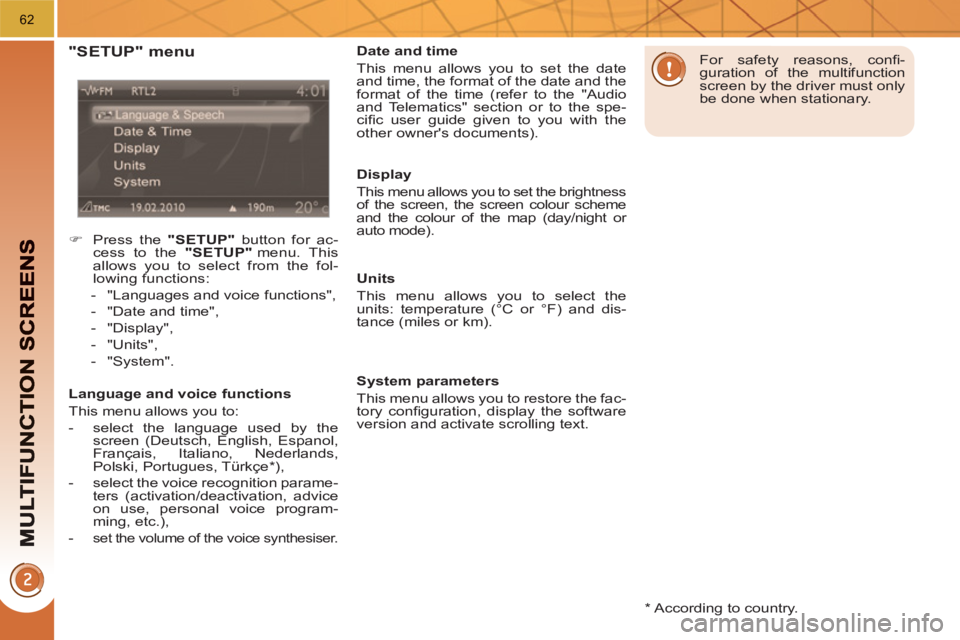
62
*
According to country.
"SETUP" menu
�)
Press the "SETUP"
button for ac-
cess to the "SETUP"
menu. This
allows you to select from the fol-
lowing functions:
- "Languages and voice functions",
- "Date and time",
- "Display",
- "Units",
- "System".
Language and voice functions
This menu allows you to:
- select the language used by the
screen (Deutsch, English, Espanol,
Français, Italiano, Nederlands,
Polski, Portugues, Türkçe * ),
- select the voice recognition parame-
ters (activation/deactivation, advice
on use, personal voice program-
ming, etc.),
-
set the volume of the voice synthesiser.
Date and time
This menu allows you to set the date
and time, the format of the date and the
format of the time (refer to the "Audio
and Telematics" section or to the spe-
cifi c user guide given to you with the
other owner's documents).
Display
This menu allows you to set the brightness
of the screen, the screen colour scheme
and the colour of the map (day/night or
auto mode).
Units
This menu allows you to select the
units: temperature (°C or °F) and dis-
tance (miles or km).
System parameters
This menu allows you to restore the fac-
tory confi guration, display the software
version and activate scrolling text.
For safety reasons, confi -
guration of the multifunction
screen by the driver must only
be done when stationary.
Page 69 of 280
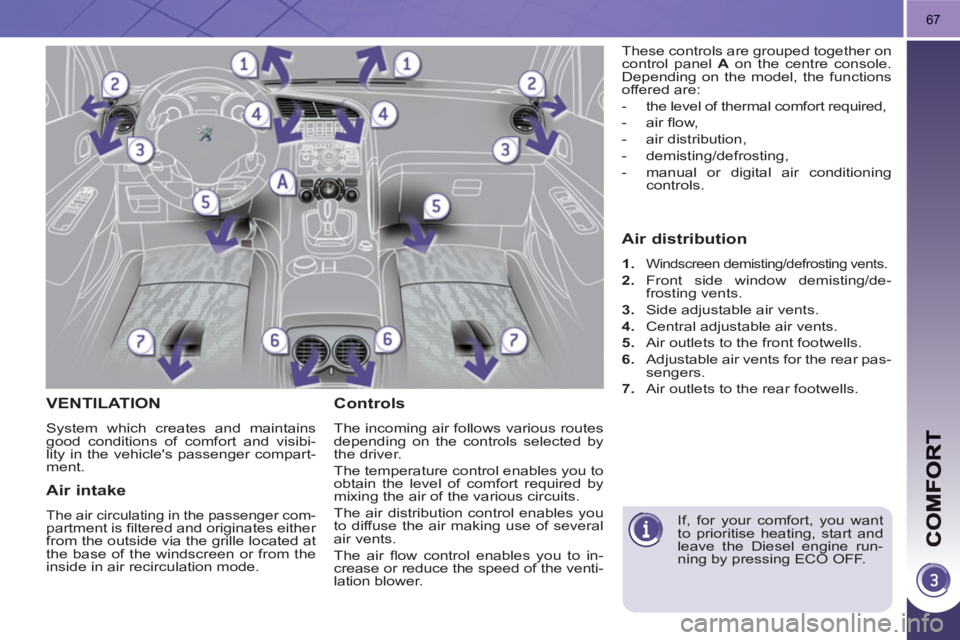
67
VENTILATION
System which creates and maintains
good conditions of comfort and visibi-
lity in the vehicle's passenger compart-
ment.
Controls
The incoming air follows various routes
depending on the controls selected by
the driver.
The temperature control enables you to
obtain the level of comfort required by
mixing the air of the various circuits.
The air distribution control enables you
to diffuse the air making use of several
air vents.
The air fl ow control enables you to in-
crease or reduce the speed of the venti-
lation blower. These controls are grouped together on
control panel A
on the centre console.
Depending on the model, the functions
offered are:
- the level of thermal comfort required,
- air fl ow,
- air distribution,
- demisting/defrosting,
- manual or digital air conditioning
controls.
Air intake
The air circulating in the passenger com-partment is fi ltered and originates either
from the outside via the grille located at
the base of the windscreen or from the
inside in air recirculation mode.
Air distribution
1.
Windscreen demisting/defrosting vents.
2.
Front side window demisting/de-
frosting vents.
3.
Side adjustable air vents.
4.
Central adjustable air vents.
5.
Air outlets to the front footwells.
6.
Adjustable air vents for the rear pas-
sengers.
7.
Air outlets to the rear footwells.
If, for your comfort, you want
to prioritise heating, start and
leave the Diesel engine run-
ning by pressing ECO OFF.